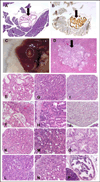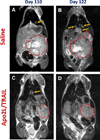Influence of the implantation site on the sensitivity of patient pancreatic tumor xenografts to Apo2L/TRAIL therapy
- PMID: 24518511
- PMCID: PMC4321692
- DOI: 10.1097/MPA.0000000000000099
Influence of the implantation site on the sensitivity of patient pancreatic tumor xenografts to Apo2L/TRAIL therapy
Abstract
Objectives: We have previously demonstrated activity of Apo2L/TRAIL against patient pancreatic tumor xenografts. Here, we have examined the influence of the tumor implantation site on therapeutic response of orthotopic tumors and their metastases to Apo2L/TRAIL.
Methods: Sensitivity of 6 patient pancreatic tumor xenografts to Apo2L/TRAIL was determined in a subcutaneous model. To compare the response of orthotopic tumors, cells from subcutaneous xenografts were injected into the pancreas. Tumor growth was confirmed by histological examination of selected mice, and then treatment was started. When all control mice developed externally palpable tumors, the experiment was terminated, and pancreatic weights compared between control and treated groups. Magnetic resonance imaging was used to quantitate the response of orthotopic and metastatic tumors.
Results: The sensitivity to Apo2L/TRAIL observed in subcutaneous tumors was maintained in orthotopic tumors. Metastatic spread was observed with orthotopic tumor implantation. In an orthotopic model of a sensitive tumor, primary and metastatic tumor burden was significantly reduced, and median survival significantly extended by Apo2L/TRAIL therapy.
Conclusions: Our data provide evidence that the site of tumor engraftment does not alter the inherent sensitivity of patient xenografts to Apo2L/TRAIL, and these results highlight the potential of Apo2L/TRAIL therapy against primary and metastatic pancreatic cancer.
Conflict of interest statement
Disclosure: The authors have no conflicts of interest.
Figures





Similar articles
-
Synergism of CPT-11 and Apo2L/TRAIL against two differentially sensitive human colon tumor xenografts.Oncology. 2008;74(3-4):188-97. doi: 10.1159/000151366. Epub 2008 Aug 20. Oncology. 2008. PMID: 18714167 Free PMC article.
-
The combination of tumor necrosis factor-related apoptosis-inducing ligand (TRAIL/Apo2L) and Genistein is effective in inhibiting pancreatic cancer growth.Pancreas. 2004 Jul;29(1):45-52. doi: 10.1097/00006676-200407000-00055. Pancreas. 2004. PMID: 15211111
-
Apo2 ligand/tumor necrosis factor-related apoptosis-inducing ligand cooperates with chemotherapy to inhibit orthotopic lung tumor growth and improve survival.Cancer Res. 2004 Jul 15;64(14):4900-5. doi: 10.1158/0008-5472.CAN-04-0408. Cancer Res. 2004. PMID: 15256461
-
The potential of the tumor microenvironment to influence Apo2L/TRAIL induced apoptosis.Immunol Invest. 2006;35(3-4):279-96. doi: 10.1080/08820130600745463. Immunol Invest. 2006. PMID: 16916755 Review.
-
Targeting Apo2L/TRAIL receptors by soluble Apo2L/TRAIL.Cancer Lett. 2013 May 28;332(2):156-62. doi: 10.1016/j.canlet.2010.11.001. Epub 2011 Jan 8. Cancer Lett. 2013. PMID: 21220186 Review.
Cited by
-
Tumor necrosis factor-related apoptosis-inducing ligand modulates angiogenesis and apoptosis to inhibit non-small cell lung carcinoma tumor growth in mice.J Int Med Res. 2019 Jul;47(7):3243-3252. doi: 10.1177/0300060519854293. Epub 2019 Jun 24. J Int Med Res. 2019. PMID: 31234689 Free PMC article.
-
The MKK7 p.Glu116Lys Rare Variant Serves as a Predictor for Lung Cancer Risk and Prognosis in Chinese.PLoS Genet. 2016 Mar 30;12(3):e1005955. doi: 10.1371/journal.pgen.1005955. eCollection 2016 Mar. PLoS Genet. 2016. PMID: 27028764 Free PMC article.
-
Targeting dual signalling pathways in concert with immune checkpoints for the treatment of pancreatic cancer.Gut. 2021 Jan;70(1):127-138. doi: 10.1136/gutjnl-2020-321000. Epub 2020 May 18. Gut. 2021. PMID: 32424005 Free PMC article.
-
Pancreatic cancer stem cells in patient pancreatic xenografts are sensitive to drozitumab, an agonistic antibody against DR5.J Immunother Cancer. 2016 Jun 21;4:33. doi: 10.1186/s40425-016-0136-y. eCollection 2016. J Immunother Cancer. 2016. PMID: 27330806 Free PMC article.
-
Tumor priming by Apo2L/TRAIL reduces interstitial fluid pressure and enhances efficacy of liposomal gemcitabine in a patient derived xenograft tumor model.J Control Release. 2015 Nov 10;217:160-9. doi: 10.1016/j.jconrel.2015.08.047. Epub 2015 Sep 3. J Control Release. 2015. PMID: 26342663 Free PMC article.
References
-
- Francia G, Kerbel RS. Raising the bar for cancer therapy models. Nat Biotechnol. 2010;28:561–562. - PubMed
-
- Killion JJ, Radinsky R, Fidler IJ. Orthotopic models are necessary to predict therapy of transplantable tumors in mice. Cancer Metastasis Rev. 1999;17:279–284. - PubMed
-
- Ashkenazi A, Holland P, Eckhardt SG. Ligand-based targeting of apoptosis in cancer: the potential of recombinant human apoptosis ligand 2/Tumor necrosis factor-related apoptosis-inducing ligand (rhApo2L/TRAIL) J Clin Oncol. 2008;26:3621–3630. - PubMed
MeSH terms
Substances
Grants and funding
LinkOut - more resources
Full Text Sources
Other Literature Sources
Medical

